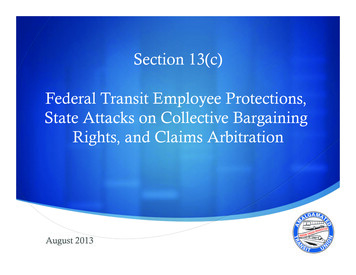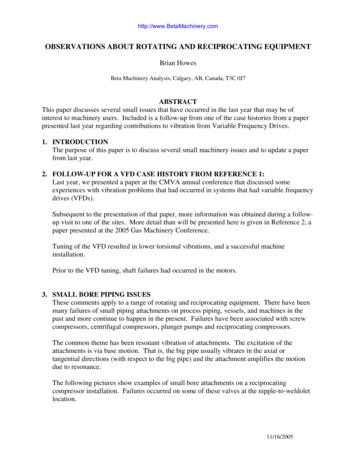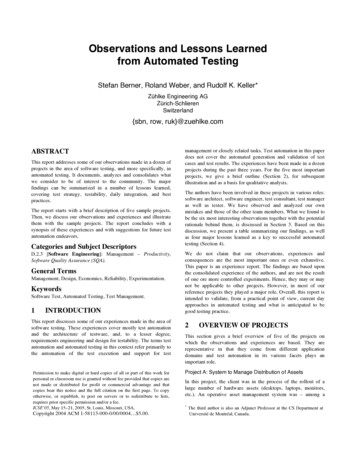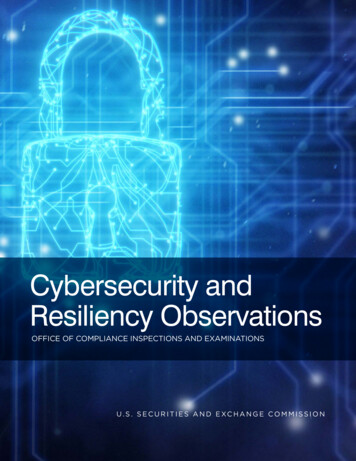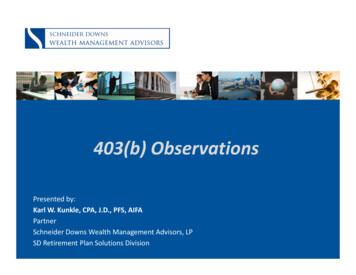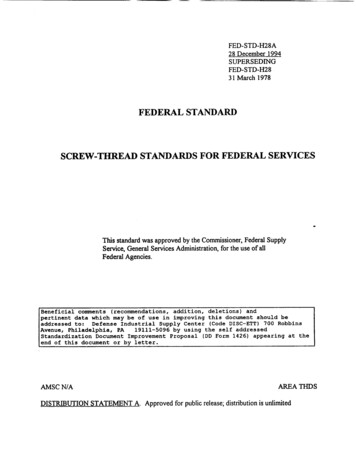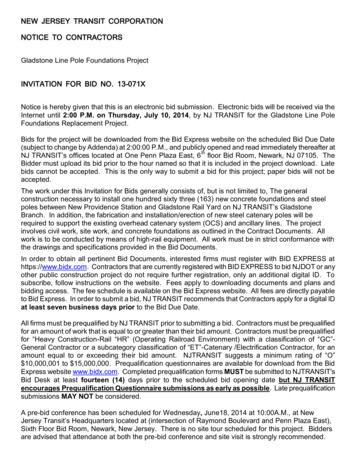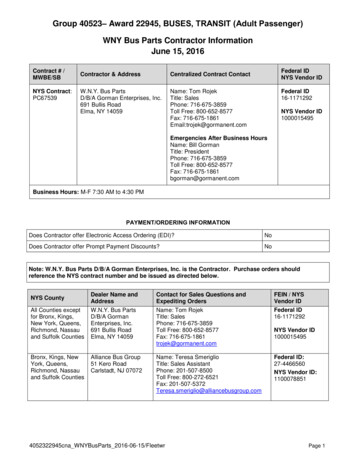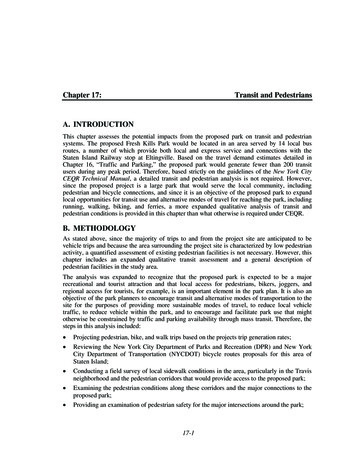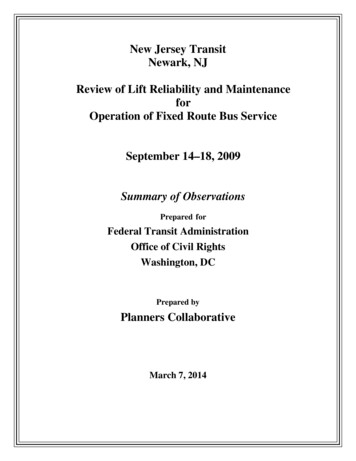
Transcription
New Jersey TransitNewark, NJReview of Lift Reliability and MaintenanceforOperation of Fixed Route Bus ServiceSeptember 14–18, 2009Summary of ObservationsPrepared forFederal Transit AdministrationOffice of Civil RightsWashington, DCPrepared byPlanners CollaborativeMarch 7, 2014
New Jersey Transit: ADA Lift Reliability and Maintenance ReviewDraft ReportTABLE OF CONTENTS1Purpose of the Review .12Background .33Overview of the Review .643.1Customer Comments . 93.2NJ Transit Policies and Procedures. 123.3Service Monitoring and Enforcement Procedures . 153.4Review Team Observations . 27Findings and Recommendations.364.1Findings. 364.2Recommendations. 39ATTACHMENTSA. FTA Notification LetterB. On-Site Review ScheduleC. NJ Transit Response LetterD. NJ Transit Policies and ProceduresE. Investigator Service Quality Performance ReportF. Bus Condition ReportG. Excerpts from Accessibility Audit within Maintenance SOPH. NJ Transit Bus FleetI. Driver Interview FormJ. Record of Lift Cycling/Working Condition of Lifts and Access FeaturesK. Bus and Van Specification Checklist
New Jersey Transit: ADA Lift Reliability and Maintenance ReviewDraft Report1 Purpose of the ReviewU.S. Department of Transportation (DOT) regulations implementing the Americans withDisabilities Act of 1990 (ADA) contain two primary provisions to ensure that transit authoritiesreliably and properly maintain vehicles with accessibility features in Section 31.167. Generalequipment maintenance requirements, which pertain to all types of entities and services, includethe following:(a) Public and private entities providing transportation services shall maintain inoperative condition those features of facilities and vehicles that are required to makethe vehicles and facilities readily accessible to and usable by individuals withdisabilities. These features include, but are not limited to, lifts and other means ofaccess to vehicles, securement devices, elevators, signage and systems to facilitatecommunications with persons with impaired vision or hearing.(b) Accessibility features shall be repaired promptly if they are damaged or out oforder. When an accessibility feature is out of order, the entity shall take reasonablesteps to accommodate individuals with disabilities who would otherwise use thefeature.(c) This section does not prohibit isolated or temporary interruptions in service oraccess due to maintenance or repairs.In addition to the general equipment maintenance provisions described above that apply to alltransportation providers, Section 37.163 of the DOT ADA regulations requires public entities tokeep vehicle lifts in operative condition as follows:(a) This section applies only to public entities with respect to lifts in non-rail vehicles.(b) The entity shall establish a system of regular and frequent maintenance checks oflifts sufficient to determine if they are operative.(c) The entity shall ensure that vehicle operators report to the entity, by the mostimmediate means available, any failure of a lift to operate in service.(d) Except as provided in paragraph (e) of this section, when a lift is discovered to beinoperative, the entity shall take the vehicle out of service before the beginning of thevehicle’s next service day and ensure that the lift is repaired before the vehicle returnsto service.(e) If there is no spare vehicle available to take the place of a vehicle with aninoperable lift, such that taking the vehicle out of service will reduce thetransportation service the entity is able to provide, the public entity may keep thevehicle in service with an inoperable lift for no more than five days (if the entityserves an area of 50,000 or less population) or three days (if the entity serves an areaof over 50,000 population) from the day on which the lift is discovered to beinoperative.(f) In any case in which a vehicle is operating on a fixed route with an inoperative lift,and the headway to the next accessible vehicle on the route exceeds 30 minutes, theentity shall promptly provide alternative transportation to individuals with disabilitieswho are unable to use the vehicle because its lift does not work.Page 1
New Jersey Transit: ADA Lift Reliability and Maintenance ReviewDraft ReportDOT ADA regulations also contain several requirements related to the operation of accessibilityfeatures. Part 38 of the regulations requires accessible vehicles to have mobility aid securementsystems and passenger restraint systems and includes technical and functional specifications forthese securement and restraint systems. The regulations require that transit systems use thesecurement system available on vehicles. Section 37.165 requires that agency personnel assistindividuals with disabilities with the use of lifts, ramps, and securement systems (and that theyleave their seat if necessary to provide this assistance). Section 37.173 then requires transitagencies to ensure that “personnel are trained to proficiency, as appropriate to their duties, sothat they operate vehicles and equipment safely and properly assist and treat individuals withdisabilities who use the service in a respectful and courteous way, with appropriate attention tothe differences among individuals with disabilities.”The Federal Transit Administration (FTA) ensures compliance with the ADA and the DOTimplementing regulations. As part of its oversight efforts, FTA, through its Office of CivilRights, conducts periodic reviews of fixed route transit services operated by grantees.This report includes the results of the review of lift reliability, maintenance, and operation at theNew Jersey Transit Corporation (NJ Transit), operating throughout the state of New Jersey. Thereview team conducted the review from September 14–8, 2009. This report summarizes theobservations and findings of the on-site review of NJ Transit’s fixed route bus service byproviding a description of key features of the fixed route bus service, followed by a descriptionof the approach and methodology used to carry out the review, and finally describingobservations and findings related to the ADA requirements. The last section summarizes themajor findings of the review and provides recommendations for addressing identified issues.Page 2
New Jersey Transit: ADA Lift Reliability and Maintenance ReviewDraft Report2 BackgroundThe Public Transportation Act of 1979 created the New Jersey Transit Corporation (NJ Transit)to “acquire, operate and contract for transportation service in the public interest.” In 1980, NJTransit purchased Transport of New Jersey, the state’s largest private bus company at that time.Between 1981 and 1985, NJ Transit incorporated the services of several other bus companies. OnJanuary 1, 1983, a second subsidiary (NJ Transit Rail Operations, Inc.) assumed control ofcommuter rail. In 1984, a third subsidiary (NJ Transit Mercer, Inc.) assumed control of busservice in the Trenton/Mercer County area. In 1992, NJ Transit unified all three subsidiaries.Appointed by the Governor, the NJ Transit Board of Directors has seven members—fourmembers of the general public and three state officials—who select an Executive Director toadminister the entire agency and to serve as President of the three subsidiaries. In addition, NJTransit employs a Chief Operating Officer to coordinate operations. NJ Transit’s board meetsmonthly at NJ Transit headquarters in Newark. Additional input is provided by two transitadvisory committees, the North Jersey Transit Advisory Committee (14 members, 4-year terms)and the South Jersey Transit Advisory Committee (14 members, 3-year terms).Covering a service area of 5,325 square miles, NJ Transit is the nation’s third largest provider ofbus, rail, and light rail transit, linking major points in New Jersey, New York City, andPhiladelphia. The agency operates a fleet of more than 2,000 buses, 700 trains, and 45 light railvehicles. NJ Transit also administers several publicly-funded transit programs for people withdisabilities, older adults, and people living in the state’s rural areas who have no other means oftransportation. In addition, the agency provides support and equipment to private contractors.According to its FY 2009 Annual Report, NJ Transit provided 270.3 million passenger trips thatyear on all modes.NJ Transit buses operate throughout the state as well as in Philadelphia and New York City. Ithas 15 bus garages, a central bus maintenance facility, and more than 24 passenger terminals andtransfer centers (some of which are shared with other transit agencies). NJ Transit also providesfixed route bus service under contract with 24 private bus carriers operating out of their ownfacilities. Table 2.1 lists the 15 NJ Transit bus garages.Page 3
New Jersey Transit: ADA Lift Reliability and Maintenance ReviewDraft ReportTable 2.1 – NJ Transit Bus GaragesGarageBig TreeEgg Harbor TownshipFairviewGreenvilleHamilton TownshipHiltonHowellIronboundMarket StreetMeadowlandsNewton AvenueOradellOrangeWashington TownshipWayneNJ LocationNutleyEgg HarborFairviewJersey CityHamiltonMaplewoodHowellNewarkPatersonNorth BergenCamdenOradellOrangeWashington TownshipWayneNJ Transit contracts with 14 private carriers to provide bus service on a variety of routesthroughout the state. Table 2.2 lists the 14 private carriers operating under contract to NJ Transit.Page 4
New Jersey Transit: ADA Lift Reliability and Maintenance ReviewDraft ReportTable 2.2 – Private Carriers under Contract to NJ TransitCarrierA&C Bus Corp./Montgomery & WestsideAcademy ExpressAcademy Lines LLCAcademy /No. 22 Hillside Corp.Bergen Avenue IBOABroadway IBOACarefree Bus LinesCommunity Transportation/TransitService AreaHudson County AreaMiddlesex County Local, Plainfield LocalMiddlesex Monmouth & Ocean County AreaHudson County Local, Bergen County LocalHudson County AreaHudson County AreaClifton to New YorkPassaic & Bergen CountiesMontclair to New York (PABT), Rtes. 32, 33, 44, 66, 88,DeCamp Bus Lines99Delaware River Coach LinesWarren County MinibusFirst StudentMorris & Warren MinibusHudson Transit Lines/ ShortlineWeehawken to Sloatsburg NY, Rtes. 17, 31, 51, 62Independent BusLiberty State Park/Ride, Newark Area – Rte. 31Lakeland Bus Lines, Inc.Dover/Sparta to New York, Rtes. 24, 78, 46, 80New York to Newark Airport, Fanwood – PABT,Olympia Trails Bus Co. Inc.Rte. 300Orange-Newark-Elizabeth Bus Inc. Elizabeth/Orange/Newark, Rtes. 24, 44Pabco Transit, Inc.Morris County LocalEssex/Middlesex Minibus, Journal Sq./Downtown LibertyRed & Tan Tours/Seven Bus Corp. State Park, Jersey City – Journal Square, Rtes. 3, 4, 5, 11,16, 122/144, 231Bergen County/ PABT, Staten Island/Spring Valley,Rockland Coaches, Inc.Rtes.11AT, 11C, 25, 20, 20T, 45, 46, 47, 49, 48, 9, 9A,84/84LSalem Community Bus ServiceSalem County LocalSuburban Transit Corp./Hunterdon/Somerset/ Union Minibus, EastSuburban TrailsBrunswick/Princeton/Plainsboro, to PABT – Wall StreetDoylestown – New York Rte. 1, Allentown toTrans-Bridge Lines, Inc.PABT/Wall Street – Rte. 2Bayonne/Jersey County – New York, Rtes. 10, 99, 99S,Trans-Hudson Express, Inc.Staten Island – HobokenVeolia TransportationMonmouth County LocalSource: NJ TransitPage 5
New Jersey Transit: ADA Lift Reliability and Maintenance ReviewDraft Report3 Overview of the ReviewThis ADA Lift Reliability and Maintenance Review focused on NJ Transit’s compliance with theDOT’s ADA regulatory requirements related to the operation and maintenance of lifts asrequired for accessible fixed route bus service.FTA provided NJ Transit with written notification of the review on August 12, 2009 (seeAttachment A). In the letter, FTA requested NJ Transit to provide the following information: Current fixed route system map (five copies) Current detailed route schedules (complete set) Identification of routes operated by NJ Transit and routes operated by private contractors Identification of routes/areas served by each garage Bus fleet inventory identifying year, make, bus garage, and accessibility of each bus,including whether and to what extent the system uses low-floor buses Description of lift maintenance practices identifying name and location of partyperforming lift maintenance Current fixed route driver manuals, notices, memoranda, or other documentationinforming drivers about lift operation and maintenance procedures Reports, memoranda, or other documentation regarding lift operation and maintenancemonitoring activities and findings Complaints received related to lift operations in the past yearThe letter also requested that NJ Transit schedule an opening conference on Monday, September14, 2009, and an exit conference on Friday, September 18, 2009.Planners Collaborative, Inc., of Boston conducted the review on behalf of FTA. David Chiaserved as the review team leader. Jim Purdy, John Hersey, and Brian Barber assisted with thereview. Attachment B details the on-site schedule.Prior to the on-site visit, the review team received and assessed a complete packa
3.2 NJ Transit Policies and Procedures . Section 37.163 of the DOT ADA regulations requires public entities to keep vehicle lifts in operative condition as follows: (a) This section applies only to public entities with respect to lifts in non-rail vehicles. (b) The entity shall establish a system of regular and frequent maintenance checks of lifts sufficient to determine if they are .

